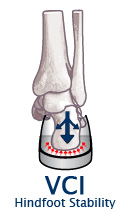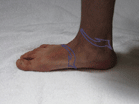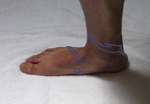This section is designed to help you or your client find the appropriate shoes for specific body types and activities.
Remember, shoes can make a major difference in the amount of support given to your feet, knees, hips and, in fact, your entire body. OPIS™ will aid you in finding the perfect shoe for your individual needs.
Determining Foot Pattern
Compare your feet and water footprints to the images seen above. All pictures were taken in a weight bearing position (standing). Once again, these images should only be used as a casual guide until you can be evaluated properly.
The most accurate way to determine your foot pattern is to have a professional observe you walking barefoot. A doctor, physical therapist or a specialty running store should be able to do this for you. Although not perfect, the “water” test can also give you some idea of your foot type. This entails getting your feet wet, walking on dry cement, and observing the prints left behind (see images above).
Please remember that foot patterns are defined by the motion of the foot (or lack thereof) through the gait cycle, and not solely the height of the arch. Although the type of heel strike can often be determined by the wear of a shoe, shoe wear does not always indicate the actual foot pattern (which occurs in the mid-stance of the gait cycle, after heel strike).



















